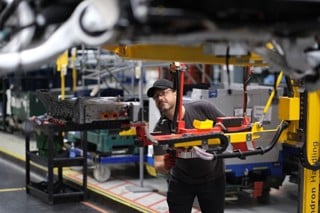Last month’s article looked at the various strategies van operators adopted in the control of fuel costs. This month we turn our attention to another significant source of cost and disruption to van operations and look at the impact of vehicles being unavailable.
Planned and unplanned ‘vehicle off road’ (VOR) time disrupts service provision and adds cost to operational budgets. Despite this statement of the obvious, only 36% of respondents to a recent FTA Van Excellence survey measured their van fleets’ VOR time.
Several respondents assigned a cost to each day their vans were unavailable. This will, of course, vary from operation to operation but the costs are significant.
Many civil engineering companies put the cost in the region of £3,000 to £4,000 per day. Lee Jackson, fleet manager at HSS Hire, puts the cost to their business as being around £1,500 per day.
“This takes into account not just the downtime of the vehicle itself but also the cost of lost business,” said Jackson.
In exploring this issue it is useful to distinguish between planned and unplanned VOR time. We would include regular service/maintenance and ‘duty of care’ inspections as planned and time off road due to breakdown, collisions, delays in service/maintenance and repair schedules as being unplanned.
Planned VOR time should, in the words of Donald Rumsfield, be a ‘known, known’.
Operators of heavy commercial vehicles have long mastered the use of a simple year planner to manage services, preventative maintenance inspections, VED dates etc.
When looking to minimise the impact of planned events there are a number of recurring strategies reported.
“We liaise carefully with the lease provider to schedule maintenance out of hours where it will have the least disruption to our business,” said Rory Morgan, national logistics general manager at Iron Mountain.
“We also look at how we can move vehicles within the fleet to even out use. By adopting a pro-active approach we’ve reduced our maintenance costs by 4.5% in 2011 while minimising the disruption of planned VOR and maintaining high safety standards”.
Accidents and breakdowns were identified as the causes of most unplanned disruptions to vehicle availability and, perhaps understandably, they were seen as being more difficult to manage.
Despite this, the consensus of those operators who measured their fleets’ VOR was that there were very clear benefits to the adoption of robust daily vehicle checks coupled with regular preventative maintenance/duty of care inspections and driver training. Catching a maintenance issue in the bud could prevent a long period of unplanned VOR at a potentially difficult time.
Morgan put the equation succinctly: “Good driver training leads to reduced incidents and less wear and tear which in turn demonstrably reduce VOR time.”
We asked operators what they considered an acceptable number of unplanned days of VOR each year.
The average answer was around three. Interestingly, for many the actual number of days experienced was more than double.
What else can be done to increase vehicle availability?
As you’d guess, the reduction of collisions was high on the agenda, with the expected feedback around driver assessment and training, use of telematics etc.
Reducing breakdowns was seen as vital. Timely fleet replacement is important despite many fleets delaying replacement. The costs and business disruption must be factored into the decision on when to replace vehicles.
Minimising the operational stress on the vehicle and ‘engineering out’ potential causes of VOR time also need to be considered. Several operators reported benefits with the adoption of automatic transmissions, speed/rev limiters and more easily repairable vehicle specifications.
Interestingly, a number of respondents reflected some frustration on the ability of maintenance and repair providers to expedite their work.
Andrew Pettiford, fleet manager at Wales and West Utilities, said: “You have to check and recheck on progress on every job. It is so important to have open communication with the providers to ensure clear expectations on vehicle availability."
Glen Williams, transport manager at ALD Logistics, agreed. “Our work is time critical delivering newspapers,” he said. “We must have accurate guidance from dealer service departments and repairers on when our vans will be back on the road. You must agree downtime with the provider and have clauses agreed in the case of a late return.”
And these views were echoed by Van Excellence Partner LeasePlan.
Mark Lovett, head of commercial vehicles at LeasePlan, said: “Our research with operators during the development and launch of our Uptime product supports the findings of the FTA’s Van Excellence survey.
“Operators need to both reduce the incidence of VOR time and, importantly, ensure they get the best possible assistance from service and repair agents to get the van back on the road. We identified cost savings of up to 60% ”
There is a clear common theme around each of the best practice strategies identified and it boils back down to the old management axiom – you can’t improve what you don’t measure.
VOR cost can be significant and unavailability of vehicles can disrupt operations with the obvious results.
There are often ways to better plan your planned VOR and there are certainly clear, proven ways to reduce unplanned VOR.
By Mark Cartwright, head of vans and LCVs, FTA






















Alan White - 27/03/2014 15:03
I love the VW Crafter so much that i have just ordered another 3 vehicles. I think they are great. But I must say - I don't know what it is like nationally but locally to me, the dealers have just taken 2 weeks to carry out 10 hours labour for repairs. This is because they are so over whelmed (a victim of their success to coin their phrase). This is typical by the way and my firm have to use independent garages to service my vehicles because they have such long lead times to do repairs at the VW dealers.(especially warranty work). Follow the service response on FB http://tinyurl.com/km5bavp